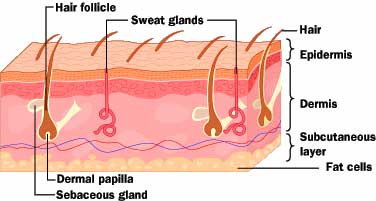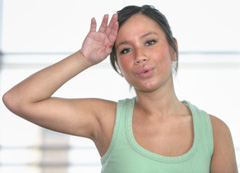Why Sweat?
“Why would you want to sweat so much, and what’s the big deal?”
Excerpts from the book “Sweat”, by Mikkel Aaland
Sitting in a sweat bath could be the most vigorous activity you’ve had all day. The heat produces an artificial “fever” and urges every organ of the body into action. While outwardly relaxed, your inner organs are as active as though you were jogging or mowing the lawn. At the same time, you are being cleansed from inside out by the skin, your body’s largest organ and its excretion, sweat.
The oldest know medical document, the Ayurveda, appeared in Sanskrit in 568 BC and considered sweating so important to health that it prescribed the sweat bath and thirteen other methods of inducing sweat. Throughout history physicians have extolled the medicinal value of the sweat bath in its various forms such as the Finnish sauna, Russian banai, Islamic hammam, or the American Indian sweatlodge. Today, enthusiasts claim that beyond being relaxing the sauna gives relief from the common cold, arthritis, headaches, hangovers and “just about anything that ails you.” Even if these claims are somewhat exaggerated, medical evidence shows that bathing in temperatures of 9O degrees C (192 degrees F) has a profoundly beneficial effect on a healthy body.
 Sweating
Sweating
Sweating is as essential to our health as eating and breathing. It accomplishes three important things: rids the body of wastes, regulates the critical temperature of the body at 37 degrees C (98.6 degrees F), and helps keep the skin clean and pliant.
Many people, in this sedent ary age, simply don’t sweat enough, making sweat bathing particularly desirable during these times. Antiperspirants, artificial environments, smog, synthetic clothing, and a physically idle lifestyle all conspire to clog skin pores and inhibit the healthy flow of sweat. These detrimental effects are reversed in a sweat bath.*
The physiological effects of different sweat baths are not the same, due to variations in heat and humidity. For example, the body sweats more profusely in the hotter (80-100 degree C) and drier (15-25%) atmosphere of the Turkish bath, where moisture on your body is often merely condensation. The length of time spent in the sauna differs from time spent in other types of sweat baths. In this section, results peculiar to the sauna are noted.
When you lounge in a sweat bath, heat sensitive nerve endings produce acetylcholine, a chemical which alerts the 2.3 million sweat glands embedded in the skin. But not all of them respond. The aprocine sweat glands, located in the pubic and arm pit areas, are activated only by emotional stimuli. They carry a faint scent whose purpose is believed to arouse the sex drive.
Nevertheless, the eccrine sweat glands, by far the most abundant, respond to heat. During a 15-minute sauna, about one liter of sweat is excreted, depending upon the individual. (Normal daily rate ranges from .5 to 1.5 liters.) Eccrine sweat is clear and odorless; any odor is only created by the presence of bacteria. One of its chief functions is to cool the body by evaporation, although there are also eccrine glands on the palms of your hands and soles of your feet which react to emotional stimuli. Like the baseball batter who wets his hands for a better grip, it is believed these sweat glands were intended to provide us with a good grip on clubs, rocks or vines when our survival often depended upon them. Sweat glands on the feet provided greater traction when it came time to run.
A third kind of sweat, called insensible perspiration, originates inside and works its way through blood and other cells to the surface of the skin. Even without a sweat bath, approximately a liter of insensible perspiration evaporates each day.
A modified type of sweat gland is the milk-producing mammary gland. Some mothers in Finland believe the sauna encourages the breast’s ability to produce milk, although this hasn’t been established scientifically.
 Sweat also has the function of being a judicious garbage collector. During a 15-minute sauna, sweating can perform the heavy metal excretion that would take the kidneys 24 working hours. Ninety-nine percent of what sweat brings to the surface of the skin is water, but the remaining one percent is mostly undesirable wastes. Excessive salt carried by sweat is generally believed to be beneficial for cases of mild hypertension. Some mental hospitals use saunas in their rehabilitation programs to pacify patients. A metabolic by-product, urea, if not disposed of regularly, can cause headaches, nausea and, in extreme cases, vomiting, coma and even death. Sweating is such an effective de-toxifier that some physicians recommend home saunas to supplement kidney machines. Sweat also draws out lactic acid which causes stiff muscles and contributes to general fatigue. Sweat flushes out toxic metals such as copper, lead, zinc and mercury which the body absorbs in polluted environments.
Sweat also has the function of being a judicious garbage collector. During a 15-minute sauna, sweating can perform the heavy metal excretion that would take the kidneys 24 working hours. Ninety-nine percent of what sweat brings to the surface of the skin is water, but the remaining one percent is mostly undesirable wastes. Excessive salt carried by sweat is generally believed to be beneficial for cases of mild hypertension. Some mental hospitals use saunas in their rehabilitation programs to pacify patients. A metabolic by-product, urea, if not disposed of regularly, can cause headaches, nausea and, in extreme cases, vomiting, coma and even death. Sweating is such an effective de-toxifier that some physicians recommend home saunas to supplement kidney machines. Sweat also draws out lactic acid which causes stiff muscles and contributes to general fatigue. Sweat flushes out toxic metals such as copper, lead, zinc and mercury which the body absorbs in polluted environments.
Skin
Because it eliminates, the skin is sometimes called the “third kidney.” It is far more complex than the kidney or any other organ except the brain. It is composed of blood vessels, nerve endings, vessels for carrying Iymph, pigmentation, oil glands, hair follicles, cells that waterproof and deny entry to bacteria and, of course, the tubular, coiled sweat glands. It is so important that death by accumulated poisons occurs in a matter of hours if the skin, and its sweat passages, are smothered.
A Finnish doctor wrote: “The best-dressed of foreigners can come into a doctor’s office, and when his skin is examined, it is found to be rough as bark. On the other hand, as a result of the sauna, the skin of any Finnish worker is supple and healthy.” Properly cared for skin is better able to resist eczema, athlete’s foot, pimples and blackheads. Furthermore, combining sweat bathing and brushing with a loofa or rough brush removes flakes of dried skin cells that accumulate on the epidermis. If allowed to remain, they can clog sweat pores and oil passages and result in dry, flaky skin.
In conjunction with the sweat bath exercise, supplemental dosages of vitamins B2 and E help keep skin fresh. Cayenne pepper, ginger, peppermint are notable herbs which, when taken internally, promote sweating and healthy skin.
(An interesting note: the ability of lizards and snakes to shed old skins has fascinated many primitive societies. Some believe that if they could shed their old skins and acquire new ones, they could renew their youth. During some ceremonies, participants don the skins of animals or other human beings in a symbolic gesture of eternal youth.)
Heating and Cooling the Inner Body
Marvelous things happen beneath the skin in the heat of the sweat bath. The capillaries dilate permitting increased flow of blood to the skin in an attempt to draw heat from the surface and disperse it inside the body. The bather’s skin becomes cherry red. The heart is pressed into a faster pace to keep up with the additional demands for blood. Impurities in the liver, kidneys, stomach, muscles, brain, and most other organs are flushed out by the faster flow of juices. The skin and kidneys filter the wastes, excreting them in sweat and urine. Some researchers claim that the rapid flexing of the heart and blood vessels in the heat of the sweat bath is a healthy exercise that puts little more strain on the heart than strolling on level ground. The increased capillary volume, they say, keeps blood pressure normal. Other medical people, however, qualify their commendations. One Finnish study observed that whereas blood pressure of healthy persons remains approximately normal in a sweat bath, there occurs a marked reduction of pressure in persons suffering from high blood pressure. However, this effect is only transient, and the original condition returns soon after the sweat bath.
American doctors commonly recommend that elderly people and persons with heart problems should avoid sweat bathing. Finnish and German doctors feel otherwise. Perhaps this difference of opinion arises from the fact that the Germans and especially the Finns are more familiar with sweat bathing.
While the surface temperature of the skin may rise as much as 1O degrees C, inner temperature increases up to 3 degrees C. This is the “fever” that Hippocrates and generations of medical people after him sought, and is created as one reclines in a sweat bath! Of course it is unlikely that “every disease” can be cured by fever, but it is common knowledge that many bacterial and viral agents do not survive well at temperatures higher than normal body temperature. It is also possible that damaged cells repair themselves quicker in fever conditions due to the increased metabolic rate. Recovery from illness then comes easier and quicker.
The inner temperature rise also affects the function of important endocrine glands, the pituitary in particular. Located in the bottom center of the brain, the pituitary is known as the master gland because its hormones regulate both metabolism and the activity of other glands such as the thyroid, adrenal, ovaries and testes. Urged by the heat, the pituitary accelerates the body’s metabolism and affects the interplay of several of the body’s hormones. Some people have gone as far to say that sex drive is increased and growth stimulated in the sauna bath.
The oxygen needs of the body increase by about 2O percent so the lungs, another important eliminator of body wastes, join in the body’s quickened pace. (The lungs’ rapid exchange of carbon dioxide for oxygen is hindered in some sweat baths. In high humidity water condenses on the tiny alveoli where this exchange takes place and breathing may be slightly more difficult. On the other hand, if the air is too dry, as occurs in many American saunas, mucous membranes may become dry and damaged.) Clogged respiratory passages are opened by heat, giving relief from colds and other minor respiratory problems. Sweat bathing is not recommended for those suffering from pneumonia or other acute respiratory diseases.
 When the bocly is slowly cooled, the effects of heat are reversed–the heart calms, sweat pores close, dilated blood vessels contract and body temperature returns to normal. (The German Sauna Society recommends a warm foot bath to re-open closed blood vessels.) On the other hand, abrupt cooling brought on by a plunge into snow or icy water creates a more dramatic effect. For this reason, people with weak constitutions should avoid rapid cooling. Vessels near the skin’s surface contract, but since the skin’s metabolism returns to normal slower than the circulatory system, wastes accumulate that are normally washed out by the blood. Local vasodilators are then stimulated and blood rushes back to the skin’s surface. The heart continues to beat vigorously and you may experience psychedelic flashes bouncing across your retina from the increased adrenal activity–an unforgettable experience! Goose bumps sometimes appear, a phenomenon reminiscent of the time when our prehistoric ancestors possessed a shaggy pelt of hair. Goose bumps extended the hair, making it thicker and giving more insulating power against cold or protection from attack. The swift transition from hot to cold stimulates the kidneys and usually creates the desire to urinate.
When the bocly is slowly cooled, the effects of heat are reversed–the heart calms, sweat pores close, dilated blood vessels contract and body temperature returns to normal. (The German Sauna Society recommends a warm foot bath to re-open closed blood vessels.) On the other hand, abrupt cooling brought on by a plunge into snow or icy water creates a more dramatic effect. For this reason, people with weak constitutions should avoid rapid cooling. Vessels near the skin’s surface contract, but since the skin’s metabolism returns to normal slower than the circulatory system, wastes accumulate that are normally washed out by the blood. Local vasodilators are then stimulated and blood rushes back to the skin’s surface. The heart continues to beat vigorously and you may experience psychedelic flashes bouncing across your retina from the increased adrenal activity–an unforgettable experience! Goose bumps sometimes appear, a phenomenon reminiscent of the time when our prehistoric ancestors possessed a shaggy pelt of hair. Goose bumps extended the hair, making it thicker and giving more insulating power against cold or protection from attack. The swift transition from hot to cold stimulates the kidneys and usually creates the desire to urinate.
The typical body is 6O% water by weight and any pounds lost at this point will be promptly regained. (However, sweat baths have an indirect effect on weight loss–see appendix.) As you can imagine, the combination of sweat bathing and cooling conditions the body, and a well-tuned body is more resistant to colds, disease and infection. In cold weather, the warm glowing feeling lingers for hours, while in hot climates the body seems cooler than before the sweat bath. (See chapter 3.)
Positive Effects of Negative Ions
Physiologically, the presence of negative ions in a sweat bath is as important as the heat. The discovery of negative ions in certain types of saunas a few years ago became headline news in Finland. Until then, the healing power of the sauna was attributed to relaxation and increased circulation. Now, negative ions add startling new possibilities.
Since the early 1950s scientists have suspected that ions play an important role in how the body functions and, consequently, in how we feel. Research has shown that an abundance of negative ions ln the air we breathe is highly beneficial, while a lack of ions or a higher ratio of positive to negative can cause physical harm. The role played by ions in everyday life has become intensely topical among researchers in the medical profession.
An ion is simply a molecule with an electric charge, either positive or negative. Ionization, or ion formation, occurs when enough energy acts on a molecule to cause it to discharge an electron. Because electrons carry a negative charge, the molecule stripped of an electron has a greater positive charge and becomes a positive ion. The lost electron scoots around loose until it attaches itself to another molecule which causes the new molecule to become negatively charged–a negative ion.
Radioactive substances in the earth’s crust and cosmic rays cause most ionization. But fire, crashing water (like water falls and surf), and plants during photosynthesis can produce negative ions as well. Europeans take ion depletions seriously and simple negative ion generators have been installed in many businesses, banks, hospitals, and passenger cars and even airliner cockpits. Furthermore, in this country, Europe and the Soviet Union, negative ion therapy has been used in treatments to help burn victims heal faster, to cure respiratory diseases, to rid the body of general infections, and even to check the spread of some cancers.
Conversely, scientists have found that if the air is charged with too few negative ions and too many positives, we become anxious, fatigued and tense. This condition is known as “pos-ion poisoning,” and often occurs as the result of weather disturbances, central air conditioning, smog, and driving too long within the confines of an automobile. Pos-ion poisoning has, in fact, been linked to heart attacks, aggravated asthma, migraine headaches, insomnia, rheumatism, arthritis, hay fever, and most allergies.
The effect of negative ions on sweat bathing was discovered when researchers were trying to account for the tremendous popularity of sauna wood burning stoves over electric stoves. Subjective reasons, such as the fragrance of burned wood, did not fully explain why Finns felt so refreshed after time in a wood heated sauna and quite dulled, from certain electrically heated saunas. Tests showed that the practice of splashing water on super-heated rocks produced an abundance of negative ions. Many electric stoves, it turned out, were not getting the rocks hot enough and the glowing metal heating coils were spurting more positive ions in the air. Researchers learned that if the rocks were properly heated in electric stoves, the positive ions, being larger and less mobile, would ground out on the hot stones. The buying habits of the Finns, perhaps the most sophisticated of sweat bathers, has forced many Finnish electric stove companies to pay particular attention to their sauna stove design. Researchers also cited poor ventilation in modern saunas as a cause of positive ion buildup; but, for a discussion of the proper climatic conditions for a sauna please refer to the appendix material on construction and use. A more detailed study regarding ions and saunas can be found in Sauna Studies, published by the Sauna Society of Finland, 1977. Although tests have not been conducted on other sweat baths, it is likely similar negative ion production occurs in any sweat bath that converts water to vapor quickly. The Native American Indian sweat lodge comes to mind.

